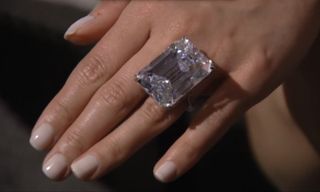
A "perfect," 100-carat diamond sold for $22.1 million yesterday at Sotheby's in New York City.
The rare gem, which Sotheby's predicted would sell for between $19 million and $25 million, is the largest flawless, colorless emerald-cut diamond ever sold at auction. The diamond, which sold for $22,090,000, was part of the auction house's Magnificent Jewels sale, which netted $65 million in total. The buyer of the giant gemstone wished to remain anonymous.
"The classic emerald-cut diamond's D color and internally flawless clarity are exceptionally rare at this scale. Including today’s result, only six perfect diamonds weighing over 100 carats have sold at auction in the last 25 years," Sotheby's said in a statement.
The diamond, which was mined in South Africa sometime in the last 10 years, was cut from a rock that was originally twice its size. That's not uncommon, as "perfect" diamonds are typically cut from a larger, imperfect hunk called a "rough," George Harlow, a mineralogist at the American Natural History Museum in New York City, who was not involved in the sale of the diamond, previously told Live Science.
Diamonds form deep below the earth under conditions of extraordinary pressure and heat. The dazzling beauties are made from carbon atoms bound together into a highly symmetrical crystal lattice. Diamonds get their color when elements of the carbon-crystal lattice are swapped with other elements, such as nitrogen, which imparts a yellowish hue to the gemstones, Harlow said.
To be flawless and colorless, a diamond must have no internal impurities or cracks. Because diamonds form deep within the mantle, which is rich in olivine and garnet, small pieces of those gemstones can often wind up in a diamond during formation, leading to dark spots. A more common crystal of carbon, called graphite, can also wind up in diamonds during their formation, Harlow told Live Science.
And tiny cracks, or "feathers," can form inside the diamond when they are crunched by the solid rock rolling over it deep below the Earth. Diamonds can also be hurt while sitting at the Earth's surface, he added.
Sign up for the Live Science daily newsletter now
Get the world’s most fascinating discoveries delivered straight to your inbox.
"We think of diamonds as being indomitable and it not being possible for them to get damaged, but in fact they can be," Harlow said.
Finding a flawless diamond is unusual, and finding one as big as 100 carats is extremely uncommon, Harlow said.
"We're talking rare upon rare," Harlow said.
Follow Tia Ghose on Twitterand Google+. Follow Live Science @livescience, Facebook & Google+. Originally published on Live Science.

Tia is the managing editor and was previously a senior writer for Live Science. Her work has appeared in Scientific American, Wired.com and other outlets. She holds a master's degree in bioengineering from the University of Washington, a graduate certificate in science writing from UC Santa Cruz and a bachelor's degree in mechanical engineering from the University of Texas at Austin. Tia was part of a team at the Milwaukee Journal Sentinel that published the Empty Cradles series on preterm births, which won multiple awards, including the 2012 Casey Medal for Meritorious Journalism.
Most Popular


